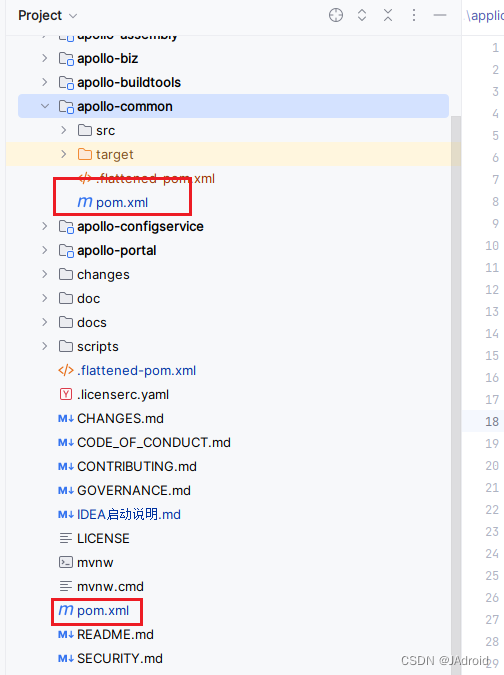当前项目中有要求需要适配多个数据库,于是需要对于apollo也需要适配多个数据库,因为apollo采用的是jpa而不是国内很多用的mybatis+mybatis plus,可能改造的地方有些不太一样,有些适配方案我是参考了这些链接,项目上的mysql迁移到DM默认schema、表名和字段名都会大写(目前apollo稳定版本是2.1.0):
apollo配置中心源码针对相关数据源切换(mysql,oracle,达梦)_apollo 替换oracle-CSDN博客
参考完后我做的修改如下:
1. pom修改
主要是对于这两个pom文件修改,增加两个依赖:

<!-- 达梦数据库 -->
<dependency>
<groupId>com.dameng</groupId>
<artifactId>DmJdbcDriver18</artifactId>
</dependency>
<!-- https://mvnrepository.com/artifact/com.dameng/DmDialect-for-hibernate5.6 -->
<dependency>
<groupId>com.dameng</groupId>
<artifactId>DmDialect-for-hibernate5.6</artifactId>
</dependency>2.修改对应application-github.properties文件
apollo中三个服务对应都会有application-github.properties文件,在这个文件中加入一行数据源驱动配置:
spring.datasource.driver-class-name=${spring_datasource_driver}3.修改对应application.yaml文件
去掉默认的mysql初始化调试参数:
# datasource:
# hikari:
# connectionInitSql: set names utf8mb44.修改AuthConfiguration.java、InstanceConfigRepository.java这两个文件
就是将`这个符号去掉,例如:
原始
@Query(
value = "select b.Id from `InstanceConfig` a inner join `Instance` b on b.Id =" +
" a.`InstanceId` where a.`ConfigAppId` = :configAppId and a.`ConfigClusterName` = " +
":clusterName and a.`ConfigNamespaceName` = :namespaceName and a.`DataChange_LastTime` " +
"> :validDate and b.`AppId` = :instanceAppId",
countQuery = "select count(1) from `InstanceConfig` a inner join `Instance` b on b.id =" +
" a.`InstanceId` where a.`ConfigAppId` = :configAppId and a.`ConfigClusterName` = " +
":clusterName and a.`ConfigNamespaceName` = :namespaceName and a.`DataChange_LastTime` " +
"> :validDate and b.`AppId` = :instanceAppId",
nativeQuery = true)现在:
@Query(
value = "select b.Id from InstanceConfig a inner join Instance b on b.Id =" +
" a.InstanceId where a.ConfigAppId = :configAppId and a.ConfigClusterName = " +
":clusterName and a.ConfigNamespaceName = :namespaceName and a.DataChange_LastTime " +
"> :validDate and b.AppId = :instanceAppId",
countQuery = "select count(1) from InstanceConfig a inner join Instance b on b.id =" +
" a.InstanceId where a.ConfigAppId = :configAppId and a.ConfigClusterName = " +
":clusterName and a.ConfigNamespaceName = :namespaceName and a.DataChange_LastTime " +
"> :validDate and b.AppId = :instanceAppId",
nativeQuery = true)5.重写CamelCaseToUnderscoresNamingStrategy.java类
这个类是hibernate-core包下的,主要是针对schema、table、column等名称的转换,在之后的启动微服务中需要配置上对应的参数,要在这个
package org.hibernate.boot.model.naming;包下,在apollo-common这个模块添加,具体如下:
package org.hibernate.boot.model.naming;
import java.util.Arrays;
import java.util.List;
import java.util.Locale;
import org.hibernate.engine.jdbc.env.spi.JdbcEnvironment;
/**
* Originally copied from Spring Boot as this strategy is popular there
* (original name is SpringPhysicalNamingStrategy).
*
* @author Phillip Webb
* @author Madhura Bhave
*/
public class CamelCaseToUnderscoresNamingStrategy implements PhysicalNamingStrategy {
// private static final List<String> keywords = Arrays.asList("comment", "cluster", "reference", "percent");
@Override
public Identifier toPhysicalCatalogName(Identifier name, JdbcEnvironment jdbcEnvironment) {
return apply( name, jdbcEnvironment );
}
@Override
public Identifier toPhysicalSchemaName(Identifier name, JdbcEnvironment jdbcEnvironment) {
return apply( name, jdbcEnvironment );
}
@Override
public Identifier toPhysicalTableName(Identifier name, JdbcEnvironment jdbcEnvironment) {
return apply( name, jdbcEnvironment );
}
@Override
public Identifier toPhysicalSequenceName(Identifier name, JdbcEnvironment jdbcEnvironment) {
return apply( name, jdbcEnvironment );
}
@Override
public Identifier toPhysicalColumnName(Identifier name, JdbcEnvironment jdbcEnvironment) {
return apply( name, jdbcEnvironment );
}
private Identifier apply(final Identifier name, final JdbcEnvironment jdbcEnvironment) {
if ( name == null ) {
return null;
}
/*StringBuilder builder = new StringBuilder( name.getText().replace( '.', '_' ) );
for ( int i = 1; i < builder.length() - 1; i++ ) {
if ( isUnderscoreRequired( builder.charAt( i - 1 ), builder.charAt( i ), builder.charAt( i + 1 ) ) ) {
builder.insert( i++, '_' );
}
}
return getIdentifier( builder.toString(), name.isQuoted(), jdbcEnvironment );*/
return getIdentifier( name.getText().replace( '.', '_' ), name.isQuoted(), jdbcEnvironment );
}
/**
* Get an identifier for the specified details. By default this method will return an identifier
* with the name adapted based on the result of {@link #isCaseInsensitive(JdbcEnvironment)}
*
* @param name the name of the identifier
* @param quoted if the identifier is quoted
* @param jdbcEnvironment the JDBC environment
*
* @return an identifier instance
*/
protected Identifier getIdentifier(String name, final boolean quoted, final JdbcEnvironment jdbcEnvironment) {
if ( isCaseInsensitive( jdbcEnvironment ) ) {
name = name.toLowerCase( Locale.ROOT );
}
// 判断是否达梦,达梦大写
if (jdbcEnvironment.getDialect().getClass().getName().equalsIgnoreCase("org.hibernate.dialect.DmDialect")) {
// String finalName = name;
// if (keywords.stream().anyMatch(str -> str.equalsIgnoreCase(finalName))) {
// return new Identifier(name.toUpperCase(), true);
// }
return new Identifier(name.toUpperCase(), true);
}
return new Identifier( name, quoted );
}
/**
* Specify whether the database is case sensitive.
*
* @param jdbcEnvironment the JDBC environment which can be used to determine case
*
* @return true if the database is case insensitive sensitivity
*/
protected boolean isCaseInsensitive(JdbcEnvironment jdbcEnvironment) {
return true;
}
private boolean isUnderscoreRequired(final char before, final char current, final char after) {
return Character.isLowerCase( before ) && Character.isUpperCase( current ) && Character.isLowerCase( after );
}
}
6.启动参数
在apollo-adminservice apollo-configservice这两个服务启动时添加的VM参数如下:
-Dspring_datasource_driver=dm.jdbc.driver.DmDriver -Dapollo_profile=github -Dspring.datasource.url=jdbc:dm://129.0.0.1:30236?ema=APOLLOCONFIGDB_2_1_0&characterEncoding=utf8&compatibleMode=mysql&clobAsString=true -Dspring.jpa.properties.hibernate.dialect=org.hibernate.dialect.DmDialect -Dspring.jpa.hibernate.naming.physical-strategy=org.hibernate.boot.model.naming.CamelCaseToUnderscoresNamingStrategy -Dspring.datasource.username=SYSDBA -Dspring.datasource.password=SYSDBA001 -Dspring.security.eureka.host=127.0.0.1 -Dspring.security.eureka.port=7761
在apollo-portal这个服务启动时添加的VM参数如下:
-Dspring_datasource_driver=dm.jdbc.driver.DmDriver -Dapollo_profile=github,auth -Ddev_meta=http://localhost:8080/ -Dapollo.meta=http://localhost:8080/ -Dserver.port=8070 -Dspring.datasource.url=jdbc:dm://127.0.0.1:30236?schema=APOLLOPORTALDB_2_1_0&characterEncoding=utf8&characterEncoding=utf8&compatibleMode=mysql&clobAsString=true -Dspring.jpa.properties.hibernate.dialect=org.hibernate.dialect.DmDialect -Dspring.jpa.hibernate.naming.physical-strategy=org.hibernate.boot.model.naming.CamelCaseToUnderscoresNamingStrategy -Dspring.datasource.username=SYSDBA -Dspring.datasource.password=SYSDBA001
如果是用的apollo自带的eureka,则在参数中不需要配置eureka相关参数,最后执行启动就可以了





















 788
788











 被折叠的 条评论
为什么被折叠?
被折叠的 条评论
为什么被折叠?








